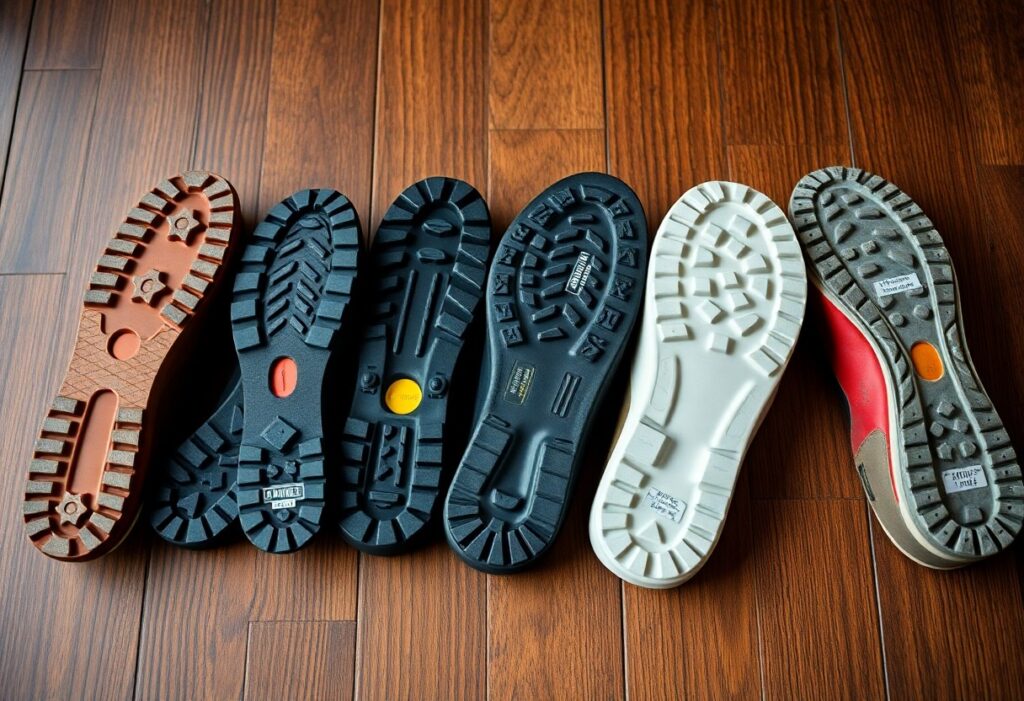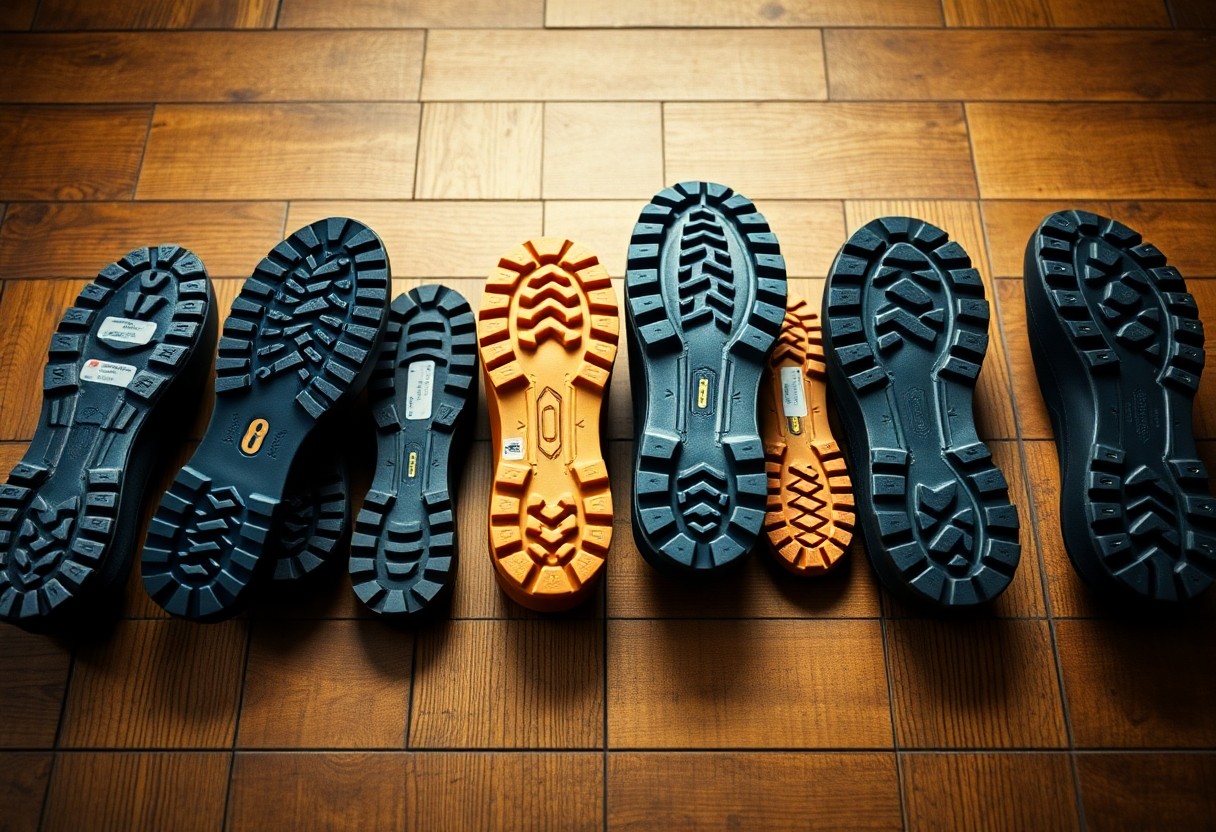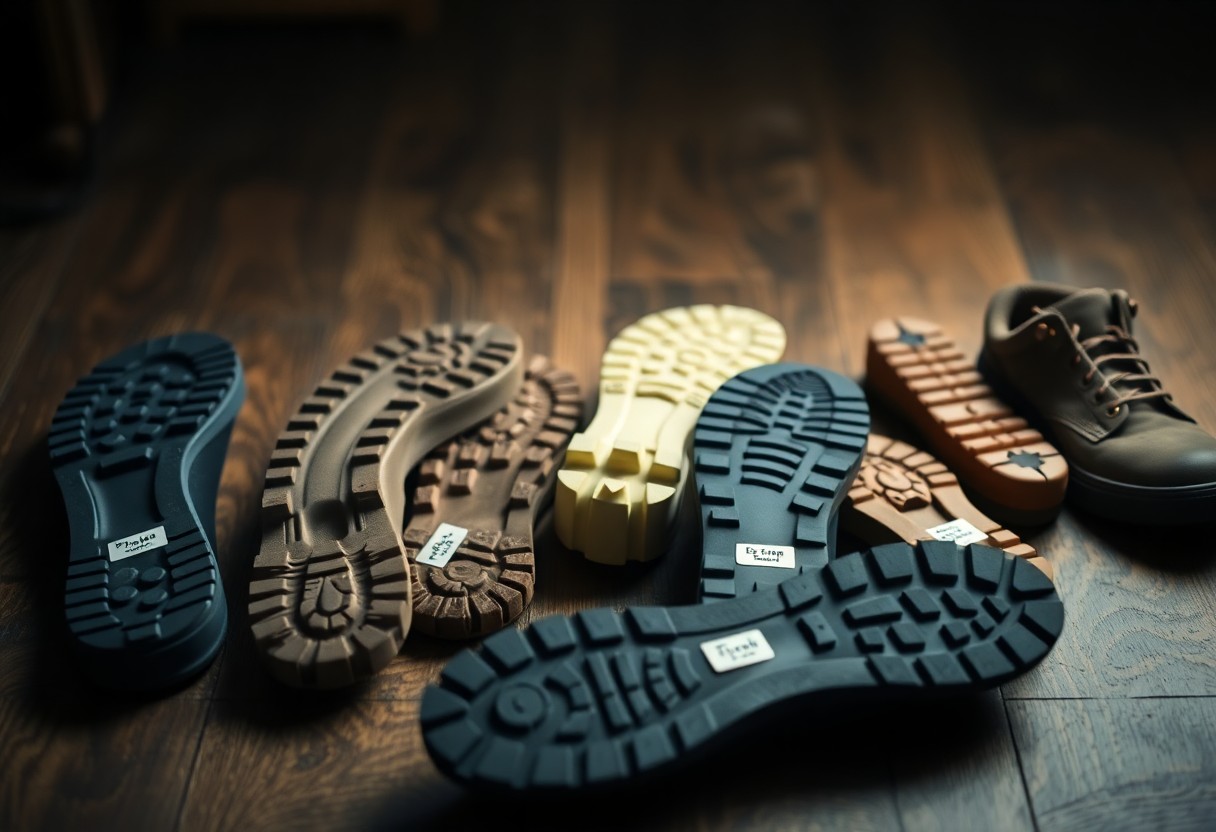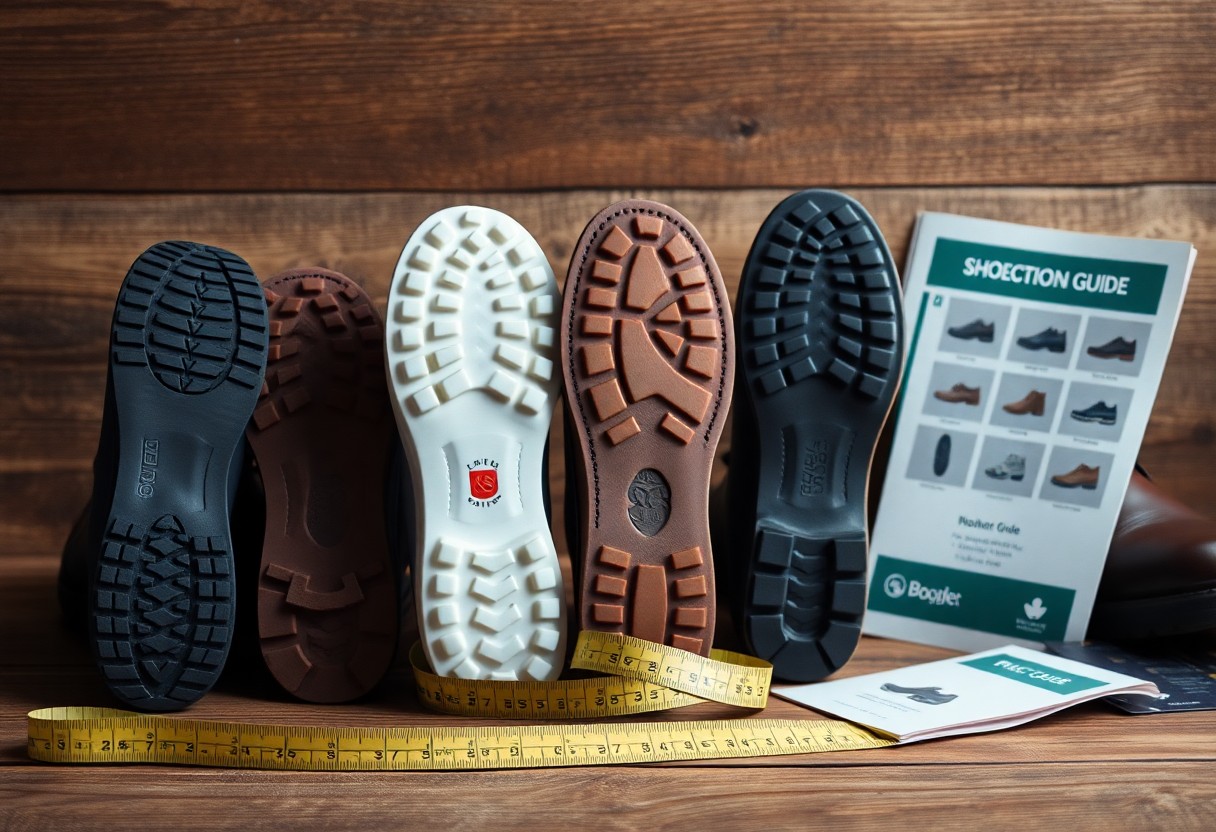
When choosing the right footwear, the importance of shoe soles is often overlooked, yet they play a vital role in ensuring your comfort and safety. The type of sole you select can dramatically affect your ability to maintain stable footing on slippery surfaces or lead to hazardous slips. Furthermore, the right sole can enhance your experience with long-lasting comfort and prevent rapid deterioration. From traditional leather to modern rubber compounds, each sole type offers distinct benefits tailored for specific uses. Options include single leather, double leather, rubber, and hybrid soles, each engineered for different environments and activities. This detailed guide will clarify the unique features of various sole types and help you choose the ideal option for your specific needs, whether you need shoes for professional, casual, or outdoor applications.

Unlock the Performance Advantages of Leather Soles for Superior Footwear
Your choice of leather soles can profoundly impact both the aesthetics and functionality of your footwear. Renowned for their superior breathability and natural comfort, leather soles adapt to your foot’s shape over time, offering a personalized fit that enhances comfort. While they require more care than synthetic options, leather soles provide excellent ground feel, which is particularly beneficial for formal occasions where elegance is essential. Familiarizing yourself with the unique advantages of leather soles will empower you to make a well-informed decision that not only elevates your wardrobe but also enriches your overall walking experience.
Elevate Your Style with the Timeless Appeal of Single Leather Soles
Soles made from a single layer of leather represent the quintessential choice for sophisticated dress shoes. Designed to deliver remarkable flexibility and a refined aesthetic, these soles can enhance your style for high-end events. While they offer better breathability compared to rubber alternatives, caution is required when traversing wet surfaces to avoid damage. By opting for single leather soles, you embrace a classic look while enjoying the comfort that stems from high-quality craftsmanship.
Enhance Your Footwear’s Longevity with Double Leather Soles
Featuring two layers of leather, double leather soles provide you with improved durability and superior insulation against cold surfaces. While they may initially feel stiffer than single leather soles, they offer essential protection for your feet in diverse conditions. This design ensures that double leather soles outlast single-layer options significantly, making them an excellent investment for daily wear. They are particularly suitable for those with a heavier build or individuals who frequently engage in outdoor activities, although a longer break-in period is necessary to optimize comfort.
By choosing double leather soles, you are selecting a durable and performance-driven solution that allows your footwear to endure the challenges of daily use while maintaining an elegant appearance.
Optimize Your Footwear’s Performance with HAF (Half and Full) Soles
HAF soles merge single leather in the waist and heel with double leather in the forepart, offering you the best of both worlds. This innovative construction ensures that you gain extra durability where it is most needed while preserving a sleek and elegant profile. The unique design of HAF soles promotes balanced weight distribution and improved comfort, effectively safeguarding high-wear areas without compromising the shoe’s refined look. It’s crucial to ensure that your cobbler incorporates appropriate heel compensation to achieve the best balance for your feet.
Discover the Flexibility of Natural and Mixed Soles for Everyday Applications
Natural and mixed soles present a versatile blend of comfort and durability. These soles combine organic materials like cork, natural rubber, or leather with synthetic substances to create adaptable and high-performance footwear options. When choosing among the various natural and mixed soles, consider your specific needs regarding grip, weight, and resistance to environmental factors. Recognizing these elements will enable you to make a well-informed decision that aligns with your lifestyle and daily activities.
Embrace Lightweight Comfort with Nitrile Cork Soles
In addition to traditional rubber options, nitrile cork soles offer a lightweight alternative that boasts remarkable durability. Composed of a blend of cork and nitrile rubber, these soles are 30% lighter than standard rubber soles, making them a favored choice for American footwear where comfort is paramount. Available in both smooth and treaded patterns, nitrile cork soles cater to those who prioritize lightweight design without sacrificing performance. Selecting these soles allows you to engage in daily activities with both ease and style.
Enjoy Everyday Comfort with Natural Crepe Soles
Constructed from pure rubber, natural crepe soles provide exceptional comfort due to their soft, cushioning qualities. These soles are ideal for casual footwear and offer varying degrees of grip depending on the surfaces you encounter. Although crepe soles deliver superior comfort for everyday use, they do have certain limitations. Their softer composition leads to a wear rate that is approximately 40% faster than traditional rubber soles, and their grip can become unreliable on wet surfaces. Therefore, while many appreciate the comfort they provide, it is essential to consider the potential need for more frequent replacements.

Explore the Performance Benefits of Rubber Soles for All Weather Conditions
In the realm of footwear, rubber soles shine by providing superior grip and water resistance compared to leather alternatives. These soles are particularly advantageous in wet conditions, making them an excellent choice for daily wear across diverse weather scenarios. Rubber soles demonstrate exceptional durability and require less maintenance than leather options, although they may feel warmer on your feet during hot summer days. The practical benefits associated with rubber soles make them a smart choice for anyone seeking reliable performance paired with comfort.
Find the Ideal Balance with Rubber Topy Soles
Rubber Topy soles serve as an excellent compromise, combining the best attributes of leather and rubber soles to provide you with the best of both worlds. You can achieve the classic look of leather soles while enjoying enhanced grip and durability. A thin rubber layer is adhered to a slightly sanded leather sole, effectively prolonging the life of your footwear by up to 50%. This combination allows you to appreciate the aesthetic appeal of leather without sacrificing functionality, making Rubber Topy soles a wise addition to your footwear collection.
Experience the Fusion of Style and Functionality with City Rubber Soles
Opting for city rubber soles enables you to achieve a sleek, dress shoe aesthetic without compromising on practicality. These slim rubber soles closely mimic traditional leather soles while offering improved traction and waterproofing. Increasingly favored in contemporary dress shoes, city rubber soles not only enhance the visual allure of your footwear but also increase longevity compared to leather soles, requiring less frequent resoling. Perfect for urban environments, these soles can navigate concrete sidewalks and occasional rain, ensuring you remain stylish and comfortable.
Maximize Durability with Dainite and Studded Soles
Among rubber options, Dainite and studded soles offer maximum durability and grip. Their distinctive studded design provides reliable traction while maintaining a formal look, making them particularly well-suited for business casual footwear and dress boots. Although Dainite soles exhibit high resistance to wear, it is worth noting that they can become slippery in freezing conditions. User experiences may vary, as some find them firmer than other sole types. However, for everyday use in moderate climates, these soles typically exceed the lifespan of traditional leather soles by 2-3 times, making them an exceptional choice for durability.
Essential Performance Characteristics of Shoe Soles
The type of shoe sole you select can profoundly influence your daily comfort and safety. Different sole types offer varying levels of grip, shock absorption, and flexibility, catering to specific needs ranging from slip prevention on wet surfaces to alleviating foot fatigue during extended periods of walking. Understanding these performance features will empower you to choose the right sole type for your needs, thereby enhancing your overall footwear experience.
Assess Durability Considerations in Sole Materials
The lifespan of different sole materials can vary significantly concerning wear resistance. Typically, rubber compounds outlast leather soles by 3-4 times, while nitrile cork offers a balanced middle ground. Factors such as material density and tread pattern are crucial in determining the longevity of your soles. Being aware of these durability considerations equips you to make cost-effective footwear choices tailored to your unique lifestyle.
Understand Weather Resistance for Optimal Sole Functionality
Key factors such as water resistance, temperature tolerance, and traction are vital for evaluating how your soles perform in diverse conditions. Generally, rubber soles provide superior grip in wet environments, while leather soles excel in dry conditions. Additionally, it’s important to note that temperature changes can significantly affect sole performance. Some rubber compounds may become dangerously hard in freezing temperatures, whereas others maintain flexibility. Your local climate should inform your choice: city rubber soles are optimal for mild, wet conditions, while specialized winter soles enhance safety in snowy or icy environments.

Your Ultimate Guide to Choosing the Right Shoe Sole
It is essential to understand that not all shoe soles are interchangeable; your choice should reflect your specific preferences and requirements. The appropriate sole type can dramatically influence your comfort, safety, and the durability of your footwear. This guide is crafted to help you select the most suitable sole type based on your lifestyle, activities, and environmental conditions.
Assess Your Daily Activities When Selecting a Sole
When choosing a sole, critical factors to consider include your daily activities and the walking surfaces you frequently encounter. In office settings, thin leather or city rubber soles are ideal. Conversely, industrial environments benefit from thick rubber or studded soles that offer greater protection. For outdoor activities, it’s crucial to prioritize grip requirements and durability needs. Understanding your primary usage will help you narrow down the best options available.
Consider Climate Factors for Optimal Sole Performance
In addition to weather conditions, temperature variations can impact the performance of shoe soles. Here are some essential considerations:
- Wet conditions – rubber soles provide superior grip
- Cold weather – thicker soles offer better insulation
- Hot climates – breathable leather soles are ideal
- Variable weather – hybrid soles deliver versatility
Grasping the climate patterns in your area is key to selecting the most suitable sole type for your footwear.
Moreover, it’s crucial to consider how different sole materials react to various weather conditions:
- Leather soles require special care in wet environments
- Rubber soles can become very hard below 0°C
- Nitrile cork provides a good balance in moderate conditions
- City rubber soles offer year-round versatility
Being aware of these characteristics helps ensure your footwear performs optimally in all seasons.
Crucial Maintenance and Care Tips for Longevity
To maximize the lifespan and performance of your shoe and boot soles, regular maintenance is essential. The durability of your soles heavily relies on proper care, which includes cleaning, drying, and protective treatments. Each sole material has its own care requirements; for example, leather soles need waterproofing, while rubber soles benefit from regular cleaning to remove debris.
Implement Effective Cleaning Techniques for Your Footwear
A well-maintained sole begins with a consistent cleaning routine. To preserve the integrity of your footwear, you should:
- Use a soft brush to gently remove dirt
- Clean with mild soap and water
- Apply specialized cleaners designed for specific materials
- Ensure thorough drying after cleaning
Recognizing the appropriate cleaning methods for your particular sole type will help prevent damage and extend the life of your footwear.
Adopt Preservation Strategies for Extended Sole Lifespan
To prolong the life of your soles, consider these valuable tips:
- Rotate your footwear daily to allow for proper airing
- Utilize shoe trees during storage to maintain shape
- Apply protective sprays as needed for added protection
- Regularly check for wear patterns to catch signs of deterioration
By being proactive and recognizing the early signs of wear, you can take measures to prevent permanent damage to your footwear.
It’s crucial to note that preservation methods can differ significantly based on the sole type:
- Leather soles necessitate waterproofing every 3-4 months
- Rubber soles should be regularly inspected for cracks
- Cork soles require protection from moisture
- Crepe soles should be kept away from extreme heat
Understanding the specific needs of your sole type will ensure optimal maintenance and longevity of your footwear.
Empower Your Footwear Choices with Informed Decisions
Your selection of shoe sole is pivotal in determining comfort and performance. It’s essential to match your sole type with your specific needs—whether that involves choosing leather soles for formal occasions or rubber variants for unpredictable weather. Factors such as your lifestyle, walking surfaces, and local climate should guide your selection. For example, a single leather sole provides an elegant touch for dress shoes, while Dainite or city rubber soles enhance grip and durability. By deepening your understanding of the various sole types and their unique benefits, you can make knowledgeable footwear choices that cater to your daily needs and personal preferences.
Common Questions Answered About Shoe Soles
Q: What are the key differences between leather and rubber soles?
A: Leather soles are celebrated for their superior breathability and adaptability to your foot’s shape over time, making them ideal for dress shoes. They perform exceptionally in dry conditions but demand careful handling in wet environments. Conversely, rubber soles provide enhanced water resistance and grip, generally last longer, and suit a wide range of weather conditions. Additionally, rubber soles are often more budget-friendly and require less maintenance compared to leather options.
Q: How do I determine the right sole type for my daily requirements?
A: When selecting the right sole type, consider your primary environments and activities. For formal office settings, leather soles are preferable, while rubber soles are more suitable for outdoor walking and wet conditions. For versatile use across varying weather scenarios, studded soles like Dainite make an excellent choice. For casual wear, crepe soles provide excellent comfort but may wear out more quickly. Aligning your sole type with your most frequent activities and environmental conditions will ensure optimal performance.
Q: What benefits do double soles offer compared to single soles?
A: Single soles offer greater flexibility and a sleeker profile, making them well-suited for dress shoes. In contrast, double soles are engineered for enhanced durability and improved insulation against cold and damp conditions. They are ideal for casual footwear and boots but do require a longer break-in period. While double soles may add some weight to the shoe, they provide additional protection for more challenging terrains.
The Article Guide to shoe and boot sole types features benefits and how to choose the right one appeared first on My Shoes Finder
The Article Shoe and Boot Sole Types: Features, Benefits, and Selection Tips Was Found On https://limitsofstrategy.com


5 Responses
It’s fascinating to delve into the intricacies of footwear, especially the often-underappreciated role that shoe soles play in our daily lives. I’ve always found that the right sole can be the difference between a pleasant day out and a regrettable experience of discomfort or even injury.
You bring up a really important point about how much our shoe soles influence our day-to-day experiences. It’s interesting to think about how something that seems so simple can have such a profound impact on our comfort and well-being.
I never thought I’d find myself pondering the existential crisis of shoe soles, but here we are! It’s funny how we often just slap on our shoes and dash out, yet those soles are basically our secret little heroes, saving us from that classic ‘banana peel’ moment. Speaking of slippery surfaces, I once took a spectacular tumble at a wedding on the dance floor—thankfully, I was wearing rubber soles that day; otherwise, I might have danced my way to the ER instead of just looking foolish!
I totally resonate with your points about shoe soles—it’s one of those things we often take for granted until we slip on a wet floor or feel our feet aching after a long day. I’ve had a few pairs of shoes with different sole types, and the difference is night and day. For instance, I used to think that leather soles were just fancy and not particularly functional, but I tried a pair with a well-crafted leather sole, and I found it offered an unexpected level of support and comfort, especially for formal occasions. On the other hand, my rubber-soled sneakers are my go-to for casual outings, as they grip better on different surfaces.
You’ve really hit on something that resonates with so many of us. It’s interesting how we often overlook the significance of shoe soles until we’re in a situation where a good grip or comfort becomes crucial. Leather soles do have that classic appeal, and your experience with them sounds spot-on. They can offer a kind of sophistication that elevates a formal outfit, and it’s surprising how well they can mold to your foot over time, providing both comfort and support. They carry a sense of style that can be hard to find in more casual footwear, but, as you’ve experienced, they can hold their own in terms of functionality too.